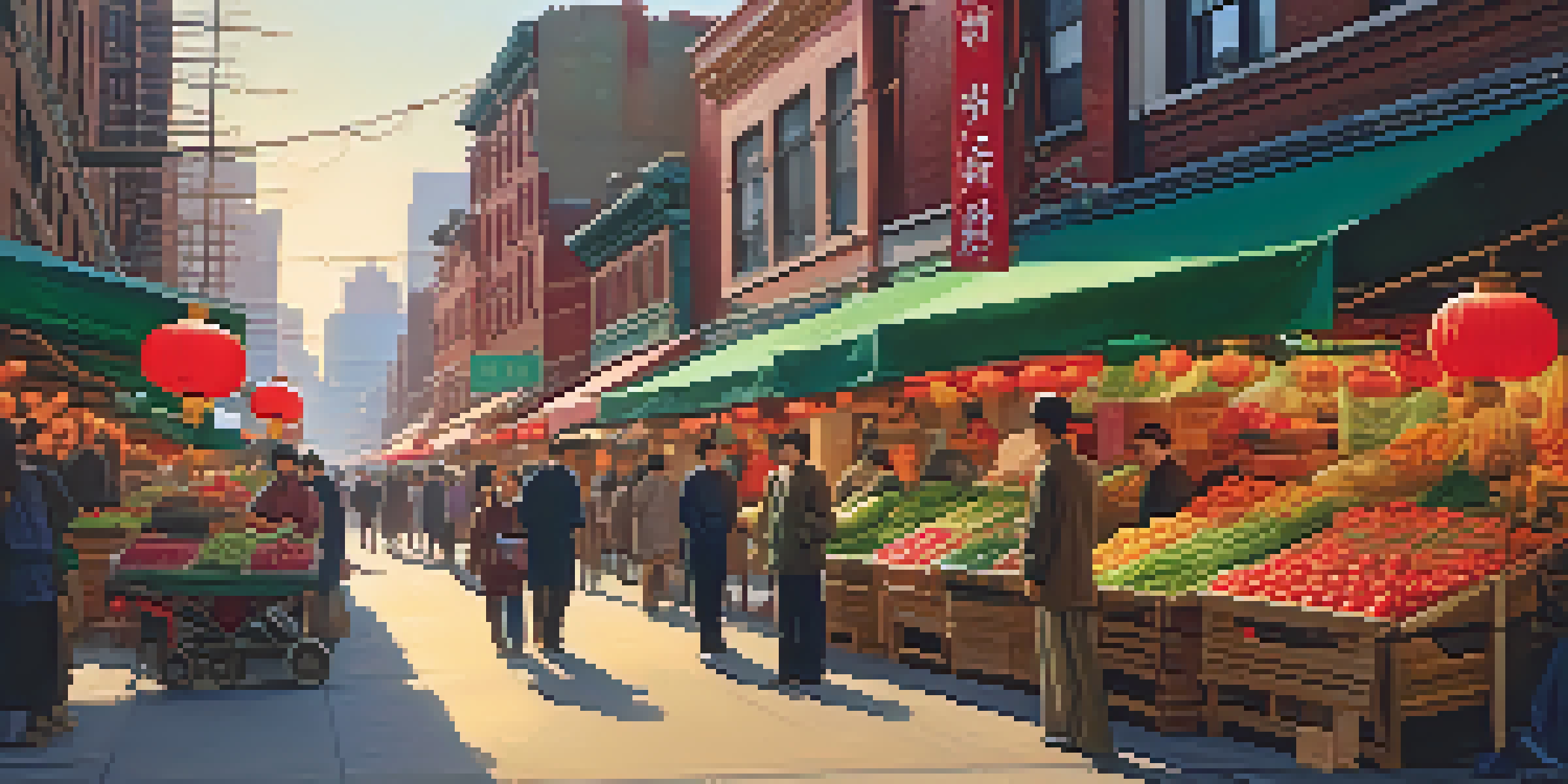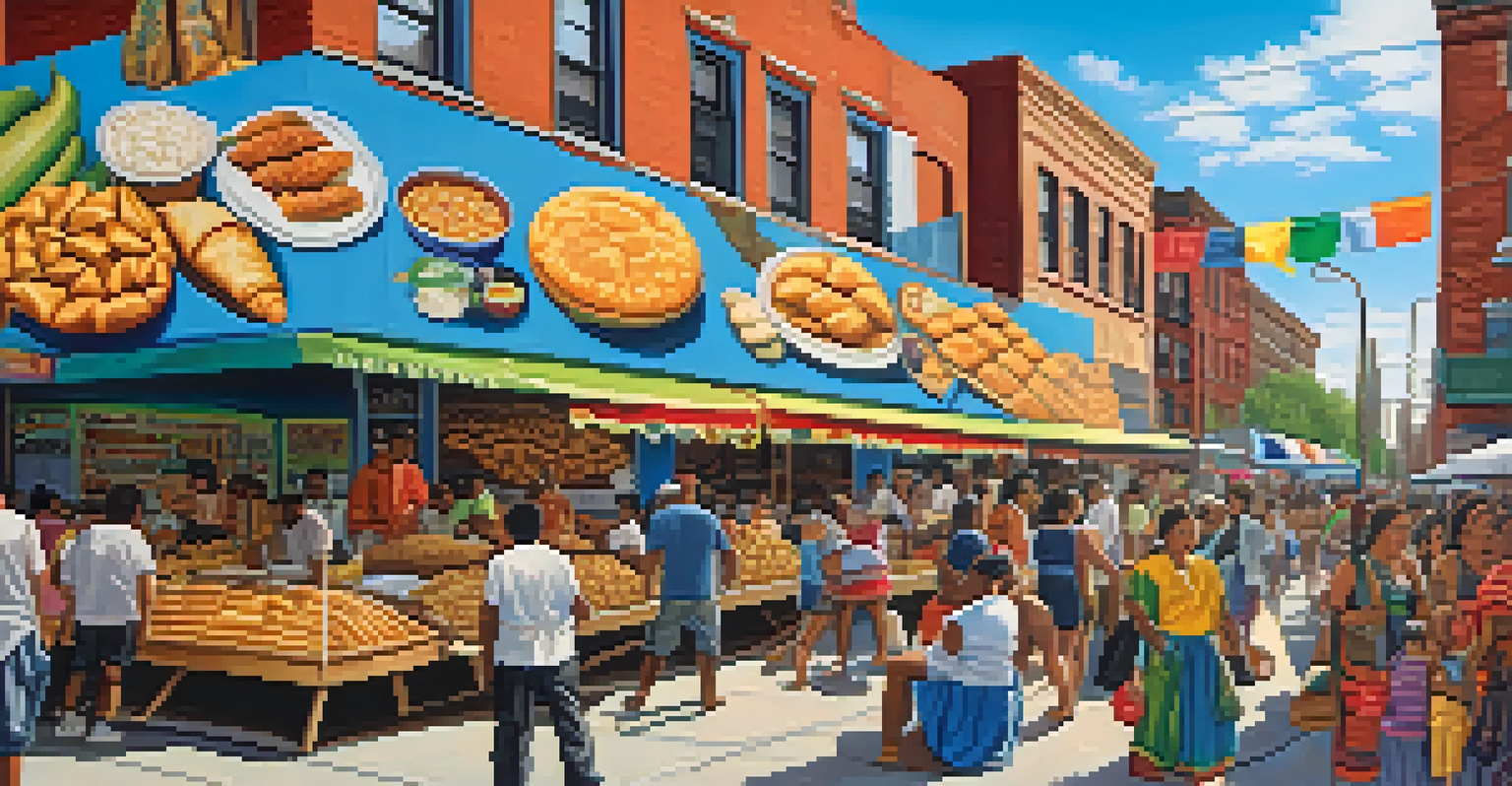New York's Neighborhoods: A Study of Cultural Enclaves

Understanding New York's Cultural Diversity
New York City is often described as a melting pot, where cultures from around the globe converge. This vibrant diversity is evident in its neighborhoods, each offering a unique cultural identity shaped by its residents. From Chinatown to Little Italy, these enclaves reflect the rich tapestry of humanity that calls New York home.
New York is not a city; it's a world.
The cultural enclaves are more than just geographical areas; they are living, breathing communities that preserve traditions, languages, and culinary delights. This vibrant mix not only enriches the city's character but also provides a sense of belonging for residents. In many ways, these neighborhoods serve as cultural ambassadors, showcasing their heritage to New Yorkers and tourists alike.
Understanding this diversity is crucial for appreciating the city as a whole. Each neighborhood has its own story, influenced by waves of immigration and historical events. By exploring these areas, one can gain insight into the broader narrative of New York City and its role as a global crossroads.
The Charm of Chinatown
Chinatown is one of the most iconic neighborhoods in New York, known for its bustling streets and rich cultural heritage. As you stroll through its vibrant markets and restaurants, you can experience the sights and sounds of Chinese culture, from traditional festivals to authentic cuisine. The neighborhood acts as a gateway for many seeking a taste of home, making it a comforting place for residents and visitors.

Culinary offerings in Chinatown are a highlight, with dim sum parlors, noodle shops, and dessert cafes lining the streets. Each bite tells a story, and the flavors reflect the diversity of Chinese regional cuisines. The neighborhood also hosts various cultural events, such as the Lunar New Year parade, which showcases traditional performances and community spirit.
New York's Neighborhood Diversity
Cultural enclaves in New York City reflect the rich diversity and heritage of its residents, showcasing unique traditions and culinary delights.
However, Chinatown is more than just food and festivals; it represents resilience and adaptation. Over the years, residents have faced challenges, yet they continue to maintain their cultural identity while integrating into the broader New York community. This blend of heritage and modernity makes Chinatown a fascinating place to explore.
Little Italy's Culinary Legacy
Little Italy, synonymous with Italian-American culture, offers a delightful escape into a world of pasta, cannoli, and lively street festivals. While the neighborhood has shrunk over the years, it remains a symbol of Italian heritage in the city. The iconic Mulberry Street comes alive during the Feast of San Gennaro, attracting locals and tourists alike to celebrate food, music, and community.
The beauty of New York is that it’s always changing, but its heart remains the same.
Dining in Little Italy is an experience in itself, with family-run establishments serving recipes passed down through generations. Whether it's a casual slice of pizza or a multi-course meal at a trattoria, the flavors are rich and authentic. This culinary legacy not only satisfies the palate but also connects diners to the stories of Italian immigrants who built this neighborhood.
Beyond the food, Little Italy is a testament to the enduring spirit of its community. The neighborhood's history is filled with tales of struggle and triumph, as immigrants forged a new life in America. Today, it stands as a reminder of the contributions of the Italian community to New York City's vibrant cultural landscape.
The Vibrancy of Hispanic Heritage in East Harlem
East Harlem, often referred to as 'El Barrio,' is a vibrant hub of Hispanic culture and community. This neighborhood is rich with the influences of Puerto Rican, Dominican, and other Latin American cultures, visible in its colorful murals, lively music, and festive celebrations. The streets pulse with life, especially during events like the Puerto Rican Day Parade, which showcases the pride and resilience of its residents.
Culinary delights abound in East Harlem, where restaurants and food trucks serve traditional dishes like mofongo, empanadas, and tostones. These flavors offer a taste of home for many residents and a delicious exploration for newcomers. The neighborhood’s markets are also brimming with fresh produce and spices, reflecting the rich agricultural traditions of Latin America.
Resilience of Cultural Communities
Neighborhoods like Chinatown and Harlem exemplify the resilience of immigrant communities, maintaining their cultural identity while adapting to change.
East Harlem embodies a strong sense of community, where families gather for cultural events and support local businesses. This neighborhood is a living example of how cultural heritage thrives and evolves, creating a dynamic environment that celebrates its roots while embracing the future.
The Artistic Soul of Williamsburg
Williamsburg, once an industrial area, has transformed into a thriving artistic enclave that attracts creatives from all over. This neighborhood is known for its hipster culture, complete with art galleries, music venues, and street art that tell the story of its evolution. Here, you can find everything from vintage shops to contemporary art installations, making it a hotspot for cultural exploration.
The culinary scene in Williamsburg is equally diverse, showcasing an array of international cuisines and innovative dining concepts. From food trucks to upscale restaurants, the neighborhood is a playground for food lovers seeking new flavors and experiences. This culinary diversity reflects the neighborhood's artistic ethos, where creativity knows no bounds.
Williamsburg is also home to numerous festivals and events that celebrate its artistic community. Events like the Northside Festival highlight local talent in music, film, and art, fostering a sense of unity and collaboration among residents. This blend of creativity and community spirit makes Williamsburg a unique cultural enclave in the heart of New York City.
The Historic Significance of Harlem
Harlem is a neighborhood steeped in history, known for its pivotal role in the Harlem Renaissance, a cultural movement that celebrated African American art, literature, and music in the early 20th century. This rich heritage is palpable as you walk through the streets, where jazz clubs and theaters continue to honor the legacy of great artists like Duke Ellington and Billie Holiday. Harlem's history is not just a chapter in a book; it’s a living narrative that shapes the community today.
The neighborhood has undergone significant changes while retaining its cultural significance. Local organizations work tirelessly to preserve Harlem's history while promoting new artistic endeavors. Events like the Harlem Week showcase the neighborhood's vibrant culture, attracting visitors to experience its music, food, and history firsthand.
Future Challenges and Opportunities
As gentrification affects cultural enclaves, community initiatives aim to preserve heritage and foster economic development, ensuring their continued vibrancy.
Harlem's culinary landscape reflects its diverse community, featuring soul food restaurants, bakeries, and cafes that celebrate African American cuisine. Dining here is more than just a meal; it's an opportunity to experience the flavors and stories that define the community. Harlem stands as a testament to resilience and creativity, making it a must-visit cultural enclave in New York City.
The Modern Vibe of Astoria
Astoria is a neighborhood that beautifully blends tradition and modernity, making it a microcosm of New York City's evolving identity. Known for its rich Greek heritage, Astoria features charming cafes, bakeries, and restaurants where you can savor authentic Mediterranean cuisine. The annual Greek Independence Day Parade is a highlight, showcasing the neighborhood's vibrant culture and community pride.
However, Astoria is also home to a diverse population, with a mix of cultures that contribute to its dynamic atmosphere. This melting pot of influences enriches the local arts scene, with galleries and theaters hosting a range of performances and exhibitions. The neighborhood’s parks and waterfront areas also provide residents with a space to relax and enjoy the outdoors.

Astoria exemplifies how neighborhoods can evolve while still honoring their roots. It's a place where old-world charm meets modern urban life, making it a welcoming home for both long-time residents and newcomers. With its blend of cultures and community spirit, Astoria continues to thrive as a unique cultural enclave in New York City.
The Future of New York's Cultural Enclaves
As New York City continues to grow and change, its cultural enclaves face both challenges and opportunities. Gentrification and rising costs can threaten the very identities of these neighborhoods, pushing out long-standing residents and altering the fabric of the community. However, many neighborhoods are also finding ways to adapt and thrive amid these changes.
Community organizations and local leaders are working to ensure that the voices of long-time residents are heard. Initiatives aimed at preserving cultural heritage while encouraging economic development are crucial for maintaining the unique character of these neighborhoods. Events that celebrate cultural traditions foster a sense of belonging and pride among residents, helping to bridge the gap between old and new.
The future of New York's cultural enclaves lies in their resilience and adaptability. As new generations of residents bring fresh perspectives and ideas, these neighborhoods will continue to evolve while honoring their rich histories. By celebrating diversity and fostering community, New York City's cultural enclaves can thrive for years to come.